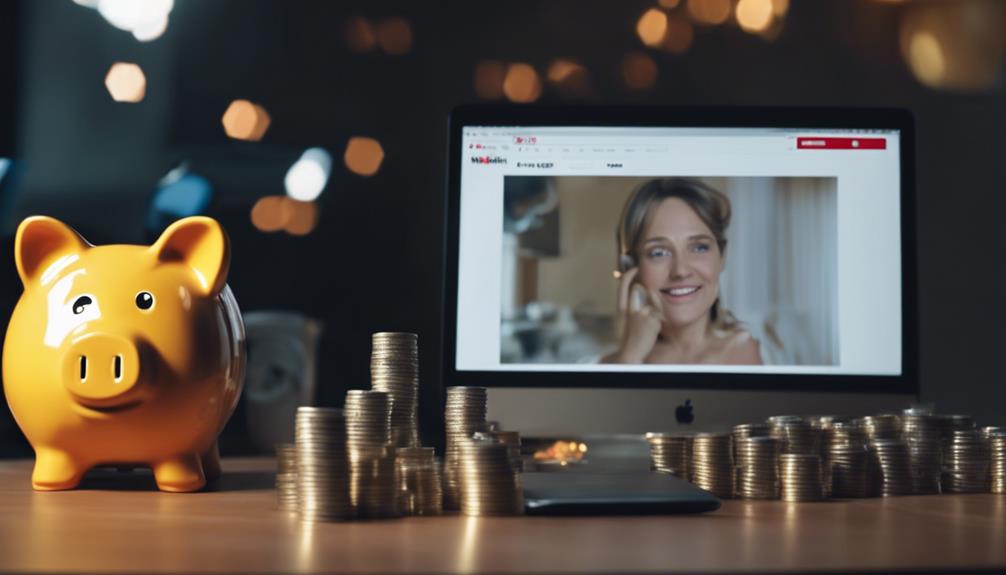
How does YouTube pay you?
Did you know that the highest-earning YouTube star made $29.5 million in 2020 alone?
You might not rake in millions, but you’re probably curious about how YouTube pays its content creators. It’s not as simple as uploading a video and watching the dollars roll in. There are requirements to meet, processes to understand, and various avenues to explore.
Want to know how it all works? Stick around—you’re about to find out.
Key Takeaways
- YouTube pays through monetization options like ad revenue, channel memberships, and merchandise shelf space for partners.
- YouTube’s payment is influenced by the algorithm, ad frequency, and content quality, which impacts viewer engagement and ad impressions.
- Meeting YouTube’s partnership requirements of 1,000 subscribers and 4,000 watch hours is necessary to start earning.
- Diversifying income sources, understanding audience preferences, and consistent content creation are key strategies to maximize YouTube earnings.
Understanding YouTube’s Monetization Policy

To grasp the mystery of how YouTube pays you, it’s essential to first understand their monetization policy, a set of rules and guidelines that governs the earning potential of your videos. This policy lays the groundwork for Monetization Eligibility, a crucial aspect that dictates how you can earn through your content. Not all channels meet these criteria, so it’s vital you do.
YouTube demands a minimum of 1,000 subscribers and 4,000 watch hours over the previous year. You’re also required to live in a region where the YouTube Partner Program is available and are mandated to abide by all of YouTube’s policies and guidelines.
The Algorithm Impact is another significant factor. YouTube’s algorithm is the secret sauce that determines which videos get promoted and who sees them. The more engaging your content, the greater the likelihood the algorithm will favor you, and the higher your earning potential.
Setting Up a YouTube Channel
Before you can start earning on YouTube, you’ll need to set up a channel that accurately represents your brand and appeals to your target audience. This involves a process called channel branding. When you’re branding your channel, think of it as your company’s storefront on YouTube. It must be unique, engaging, and a true reflection of your brand.
To start, choose a channel name that’s distinct and relevant to your brand. Pair this with a compelling logo and cover image. Remember, visuals are crucial in creating a strong first impression. The ‘About’ section of your channel should be a clear, concise summary of what viewers can expect from your content.
Next, let’s talk about content strategy. This is the plan for what, when, and how you’ll publish on your channel. Your content should resonate with your intended audience while staying true to your brand’s identity. Consistent uploads, high-quality videos, and engaging with comments can help you build a loyal following.
In essence, setting up a YouTube channel involves a blend of channel branding and a well-thought-out content strategy. Now, you’re ready to get started on your YouTube journey.
Partnering With Youtube

To partner with YouTube, you’ll need to meet certain requirements that we’ll outline here. Once you’re in, your earnings primarily come from advertisements displayed on your videos.
We’ll also guide you on how to manage your monetization settings to maximize your revenue.
Youtube Partnership Requirements
Securing a partnership with YouTube isn’t as simple as uploading a video; there are specific requirements you’ll need to meet to start earning from your content. The eligibility criteria are stringent, and rightly so, as YouTube wants to ensure quality and legality in its content. You’ll need to have more than 1,000 subscribers and over 4,000 watch hours in the previous 12 months. Plus, you need to live in a country where the YouTube Partner Program is available.
But the effort is worth it. Partnership benefits include access to a broad range of revenue streams, from ad revenue to channel memberships, and even merchandise shelf space. Remember, it’s not just about making videos; it’s about creating a sustainable business.
Earning Through Advertisements
Once you meet YouTube’s partnership criteria, you can start to earn money through advertisements placed on your videos. To maximize your earnings, you’ll need to focus on ad-driven strategies and advertisement optimization.
Here are a few key aspects:
- Quality Content: High-quality content will attract more viewers and, consequently, more ad impressions.
- Targeted Ads: Aim for ads that align with your audience’s interests. The more relevant the ads, the more likely your viewers will engage.
- Ad Frequency: Strategically determine how often ads appear on your videos. Too many can deter viewers, too few can limit earnings.
Managing Monetization Settings
Understanding and managing your monetization settings is a crucial step in your YouTube partnership journey, enabling you to control how ads are displayed on your videos. It’s not just about enabling monetization; it’s about understanding the nuances that can increase your earnings.
Here’s a quick guide:
| Action | Benefit |
|---|---|
| Enable all ad formats | Maximizes potential earnings |
| Use mid-roll ads for longer videos | Enhances viewer experience while increasing revenue |
| Understand Analytics interpretation | Identifies what’s working and what’s not |
| Monetization troubleshooting | Fixes issues affecting earnings |
Earning From Advertisements

In the world of YouTube, you can earn a significant income from advertisements that are displayed on your videos. It’s all about ad revenue diversification and influencer partnerships. When you allow ads on your videos, you’re entering into a symbiotic relationship with advertisers and YouTube itself. You provide the content, they provide the revenue.
Now, there are several ways you can earn from ads:
- Display ads: These are the banners that pop up on your video. They’re not too intrusive, and they can generate a steady income.
- Overlay ads: These are semi-transparent ads that cover part of your video. While they can be a bit more intrusive, they often provide higher revenue.
- Sponsored ads: If you’ve built a following, you can attract influencer partnerships. Brands may pay you to display their ad or mention their product in your video.
Making Money Through Memberships
You may be wondering how YouTube memberships can boost your earnings.
Simply put, when your viewers become paying members, you’ll receive a portion of their monthly subscription fees.
Let’s explore how to understand and make the most of these memberships, maximizing your potential revenue.
Understanding YouTube Memberships
Diving into the world of YouTube Memberships, it’s crucial to know that this feature offers an excellent avenue for content creators to generate consistent income. To master this, you need a solid grasp of Membership Tiers Analysis and effective Subscriber Engagement Strategies.
Membership Tiers Analysis: It’s about understanding the different levels of memberships YouTube offers, and which one suits your audience best.
Subscriber Engagement Strategies: It’s all about how you engage with your subscribers to encourage them to become members.
Consistency: Regularly providing unique, quality content is key.
Maximizing Membership Revenue
So, how can one effectively maximize membership revenue on YouTube? The answer lies in enhancing subscriber engagement and promoting exclusive content.
You’ve got to create content that’s unique and valuable enough to warrant member-only access. Think behind-the-scenes videos, special tutorials, or early access to new releases. This exclusivity adds value to memberships and encourages more sign-ups.
But it’s not just about content. Engaging with your subscribers matters, too. Respond to their comments, host live chats exclusively for members, and involve them in content creation decisions. These strategies foster a sense of community and make members feel valued – they’re more likely to keep subscribing and even bring in new members.
Other Revenue Opportunities on YouTube

Beyond the realm of ad revenues, YouTube offers a plethora of other monetization opportunities that can significantly boost your earnings. Two of these potent revenue streams are Brand Collaborations and Merchandise Selling.
Brand collaborations are partnerships between you and other businesses. They pay you to feature their products or services in your videos. This method is especially lucrative if you’ve cultivated a dedicated following that trusts your recommendations.
Merchandise selling, on the other hand, involves creating and selling your own products. You can sell anything from branded T-shirts to mugs, posters and more. YouTube even has a feature that allows you to showcase your merchandise right below your videos.
However, these aren’t the only avenues to generate income on YouTube. There are several other options, including:
- Channel Memberships: Your fans pay a monthly fee for access to exclusive badges, new emojis, and other perks.
- Super Chat & Super Stickers: These are paid comments and stickers that stand out in live chat during your live streams.
- YouTube Premium Revenue: You get a share of the fee from YouTube Premium subscribers who watch your content.

